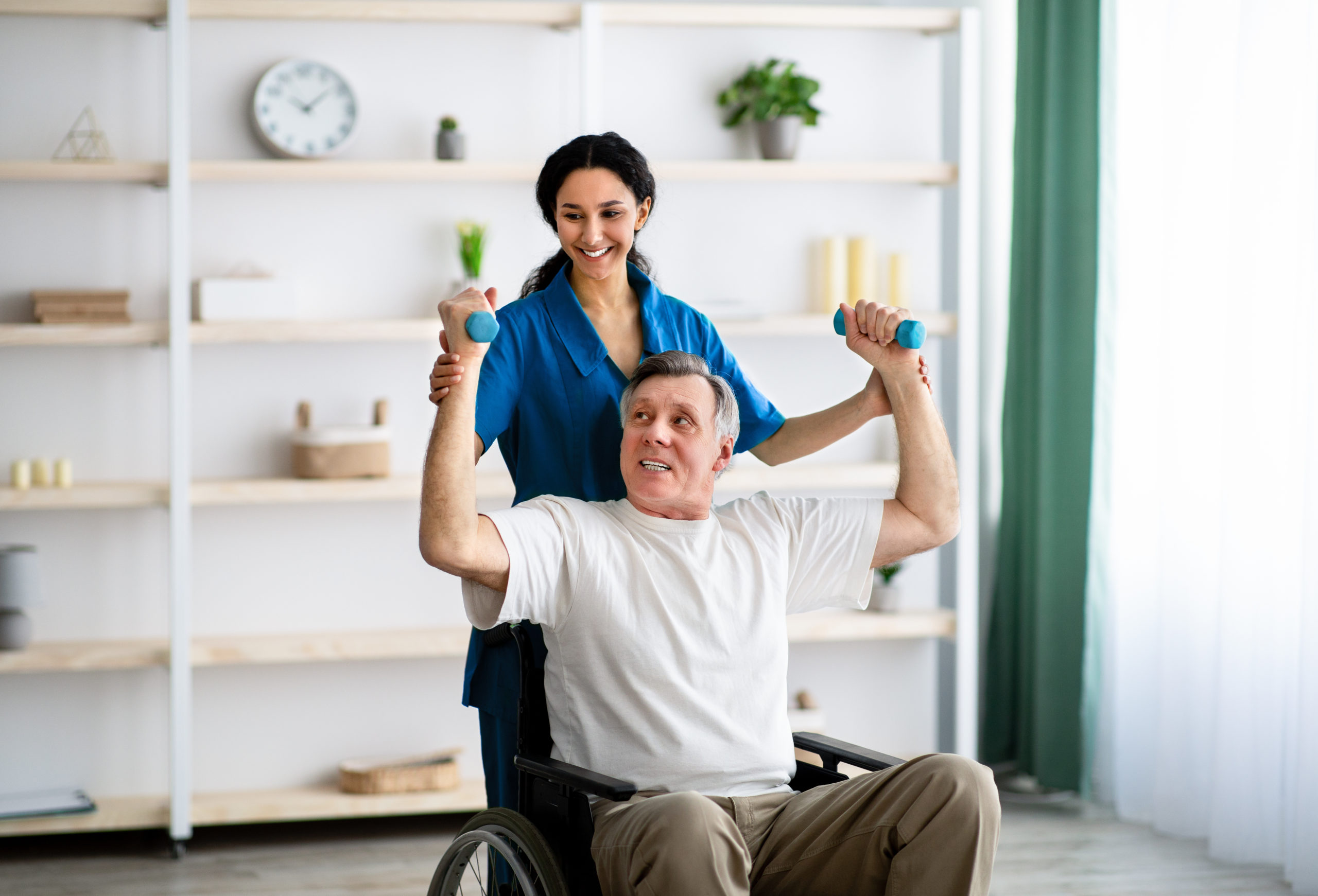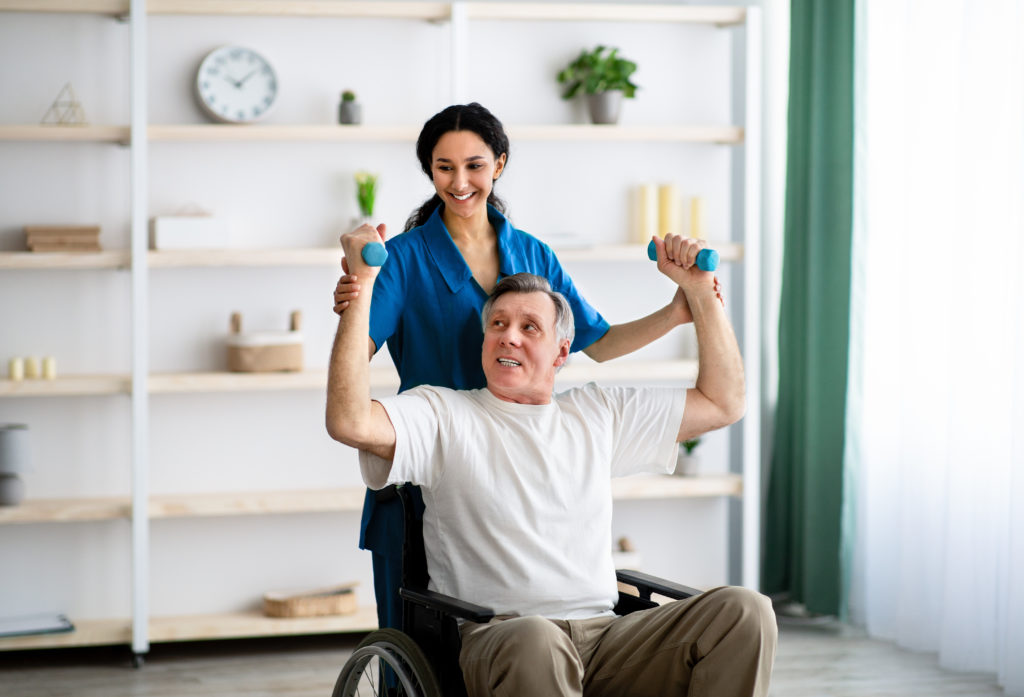

Suffering a stroke is a sudden and unexpected event that has the potential to change the course of our health and our physical function across our lifetime. While strokes are often thought to be associated with older adults, 24% of all new stroke sufferers in Australia in 2020 were aged under 55 years old.
When you have suffered a stroke, your physiotherapist is someone you will work very closely with to help you optimise your physical function and independence – often on a daily basis in the early stages of your rehab. With this week being National Stroke Awareness Week, we thought we’d look at what a stroke is, the powerful way in which physiotherapy can improve a person’s physical function after a stroke, and how our Allsports physios support our patients who have experienced a stroke.
The F.A.S.T Signs Of A Stroke
Before rehab even starts, one of the best ways to help someone suffering from a stroke is being able to recognise the signs so you can get help urgently. The Stroke Foundation has an acronym to help – FAST:
- Face: Check their face. Has their mouth drooped?
- Arms: Can they lift both arms?
- Speech: Is their speech slurred? Do they understand you?
- Time Is critical. If you see any of these signs, you must call for help by phoning 000 straight away.
What Is A Stroke?
A stroke occurs when the blood flow to a certain part of the brain is interrupted. Normally, blood carries oxygen to your brain to enable it to function properly, so when anything disrupts the oxygen levels in the brain, brain cells can become damaged, and areas of the brain stop working as they usually would.
Different portions of our brains are responsible for controlling different functions including movement, senses, emotions and thoughts, so the effects of a stroke will depend on which part of the brain has been damaged and how severe this damage is. A stroke may affect your ability to walk, talk, eat, see, read, perceive temperature, or do things you were able to do easily before the stroke.
There are three types of strokes:
- Ischaemic stroke: This stroke happens when a blood clot blocks a large blood vessel in the brain. It is the most common type of stroke, particularly in older people, and is linked to high blood pressure, high cholesterol, diabetes and smoking.
- Embolic stroke: This stroke occurs when a blood clot or piece of plaque made from cholesterol or calcium breaks off the wall of an artery and travels to the brain. This can block the flow of oxygen-rich blood to the brain and cause brain cells to become damaged.
- Haemorrhagic stroke: This stroke happens when a blood vessel in the brain bursts and leaks blood into the brain, called a cerebral haemorrhage. This can cause damage to multiple areas of the brain, and lead to more loss of function, as certain parts of the brain become deprived of blood, some become irritated by the leaked blood, and others are damaged by swelling and pressure.
How Does A Stroke Affect You?
Each person will be affected in unique ways by a stroke, depending on which parts of your brain have been damaged, and how severe the damage is. The effects can be mild to severe, and some people recover quickly, while others have more ongoing challenges. If the stroke only occurred in one half of the brain, one side of the body is often more affected than the other.
Research has found that 73% of patients recovering from a stroke experience at least one fall within the first six months of recovery, take half as many steps as the general population, and have longer periods of sedentary behaviour in their day. The effects of a stroke can also include:
- Paralysis, muscle weakness, or heaviness, usually on the affected side of the body
- Numbness in the hands, feet, arms or legs
- Difficulty speaking and closing the mouth fully
- Difficulty swallowing and drinking
- An uneven facial appearance due to the loss of muscle function on one side
- Difficulty lifting, standing or picking up objects due to muscle weakness
- When one side of the body is weaker, the other side often compensates by becoming stronger and more dominant, causing difficulties with balance and coordination
Physiotherapy For Strokes
Physiotherapy is an integral part of stroke recovery – physiotherapy can help facilitate movement and exercises that help the brain reorganise or rewire cell functions to new, healthy areas of the brain. This ability of the brain to form new neural connections and pathways is known as neuroplasticity. Physiotherapy can help patients who have experienced a stroke gain new skills, while improving and re-obtaining skills they had before. Immediately following a stroke, some areas of the brain do recover on their own, and after that, changes and improvements are due to neuroplasticity which is facilitated through physiotherapy.
Thankfully, neuroplasticity has no time limit. Historically, some doctors believed that recovery time after a stroke was limited, but studies have now found that just 2-12 weeks of physiotherapy can create long-lasting improvements in people who experienced strokes many years ago., This includes improving walking speed and distance, and better coordination in an affected hand.
Currently, the recommendations for preventing a second stroke, and reducing stroke complications, include at least 30 minutes of daily aerobic exercise, but it can be very difficult for a person who has suffered a stroke to reap the benefits from aerobic exercise as they don’t often have sufficient muscle strength to raise their heart rate, and loss of balance and coordination can also make exercising difficult. This means that regaining strength and endurance for exercise becomes a key factor that physiotherapists focus on.
As well as this, physiotherapists work on helping you achieve the independence to do every day tasks that are important and enjoyable for you. Beyond the early stages of physiotherapy, which may concentrate on basics such sitting up from a lying position, guiding the movement of a limb, and practising standing, your individual goals may include getting dressed, showering, preparing meals and going for walks, as well as attending work, participating in sports or leisure activities, or driving a car. In relearning these tasks, researchers have found five key principles that physiotherapists use to successfully increase the potential for neuroplasticity and recovery after a stroke. These include:
- Use it or lose it: Studies show that the brain can regain control of an area that was previously lost, which means it’s important to use your affected arm and leg, and do tasks that involve both hands and legs.
- Use it and improve it: Once you’ve used your affected arm or leg and made improvements, make the task harder to continue to challenge yourself.
- Specificity: Focus on a specific task. Simply opening and closing your hand is not very specific, but reaching to grasp a mug or trying to play the keys on the piano will create better results.
- Repetition: Practice, practice, practice
- Make it meaningful: Movements need to be relevant to you. If the goal is to reach and grip with your hand, try to pick up a bridle if you’re a horse rider. If you enjoy gardening, practice picking up a garden fork, and if putting on makeup is important to you, practice reaching for your foundation.
Stroke Rehab With Allsports Physiotherapy
We understand how life-altering a stroke can be, and how confusing and uncertain it can feel in the time that follows. Our physios treat each person with the greatest respect and care, with each appointment being meaningful, focused and serving to add great value to your recovery.
During your first session with us, which should be performed as early as is feasible for you, we take the time to get to know you, and complete a very detailed assessment to understand how your stroke has affected your movement, function, and your neuromusculoskeletal system. We’ll then discuss your goals, your previous levels of activity, and create a tailored rehabilitation programme to support your optimal recovery.
We’ll look at all the options to optimise your quality of life throughout the different stages of your recovery, including the use of our range of treatments and aids. We’ll discuss all of the options carefully with you, ensuring you understand exactly what the plan is, and will make changes to the plan as you progress and regain function. Your physio also stays with you throughout your rehab – regardless of how short or long that is. You’re our priority.
Your Allsports Physiotherapy team is here to help with clinics across Australia. Book your appointment with your local Allsports physio team online or call the clinic nearest you.
References
[2] Signs of stroke
[3] Falls-Related Events in the first year after Stroke in Ireland
[4] How active are people with stroke?
[5] Effect of constraint-induced movement therapy on upper extremity function 3 to 9 months after stroke
[6] Body-weight-supported treadmill rehabilitation after stroke
[7] Efficacy of physiotherapy interventions late after stroke
[8] Guidelines for the prevention of stroke in patients with stroke or transient ischemic attack
